The Water Cycle (Water Science for Schools)
The Water Cycle ¦ Water Science for Schools ¦ Contact us ¦ Back
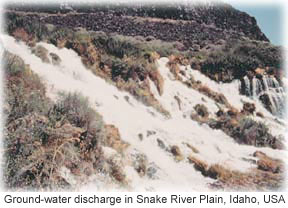 You see water all around you every day as lakes, rivers, ice, rain and snow. There are also vast amounts of water that are unseen—water existing in the ground. And even though ground water is unseen, it is moving below your feet right now. As part of the water cycle, ground water is a major contributor to flow in many streams and rivers and has a strong influence on river and wetland habitats for plants and animals. People have been using ground water for thousands of years and continue to use it today, largely for drinking water and irrigation. Life on Earth depends on ground water just as it does on surface water.
You see water all around you every day as lakes, rivers, ice, rain and snow. There are also vast amounts of water that are unseen—water existing in the ground. And even though ground water is unseen, it is moving below your feet right now. As part of the water cycle, ground water is a major contributor to flow in many streams and rivers and has a strong influence on river and wetland habitats for plants and animals. People have been using ground water for thousands of years and continue to use it today, largely for drinking water and irrigation. Life on Earth depends on ground water just as it does on surface water.
![]() Does it take days, months, years, or millennia for water to move through the ground-water system?
Does it take days, months, years, or millennia for water to move through the ground-water system?
Have you ever heard that there are rivers of water flowing underground? Do you think it is true? Actually, it is pretty much a myth. Even though there are some caverns, lava and ice tubes, and horizontal springs that can carry water, the vast majority of underground water occupies the spaces between rocks and subsurface material. Some rivers, such as the Alapaha River in northern Florida, USA, can disappear underground during low-flow periods. Generally, water underground is more like water in a sponge. It occupies the spaces between soil and rock particles. At a certain depth below the land surface, the spaces between the soil and rock particles can be totally filled with water, resulting in an aquifer from which ground water can be pumped and used by people.
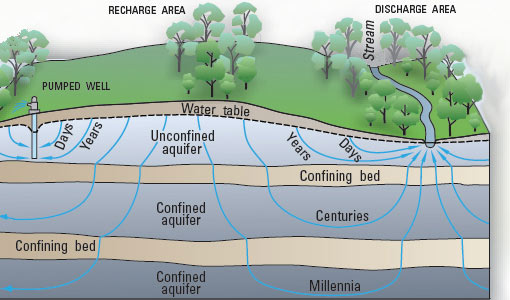 Some of the precipitation that falls onto the land infiltrates into the ground to become ground water. Once in the ground, some of this water travels close to the land surface and emerges very quickly as discharge into streambeds, but, because of gravity, much of it continues to sink deeper into the ground. If the water meets the water table (below which the soil is saturated), it can move both vertically and horizontally. Water moving downward can also meet more dense and water-resistant non-porous rock and soil, which causes it to flow in a more horizontal fashion, generally towards streams, the ocean, or deeper into the ground.
Some of the precipitation that falls onto the land infiltrates into the ground to become ground water. Once in the ground, some of this water travels close to the land surface and emerges very quickly as discharge into streambeds, but, because of gravity, much of it continues to sink deeper into the ground. If the water meets the water table (below which the soil is saturated), it can move both vertically and horizontally. Water moving downward can also meet more dense and water-resistant non-porous rock and soil, which causes it to flow in a more horizontal fashion, generally towards streams, the ocean, or deeper into the ground.
If ground water wants to be a member in good standing of the water cycle, then it can't be totally static and stay where it is. As the diagram shows, the direction and speed of ground-water movement is determined by the various characteristics of aquifers and confining layers of subsurface rocks (which water has a difficult time penetrating) in the ground. Water moving below ground depends on the permeability (how easy or difficult it is for water to move) and on the porosity (the amount of open space in the material) of the subsurface rock. If the rock has characteristics that allow water to move relatively freely through it, then ground water can move significant distances in a number of days. But ground water can also sink into deep aquifers where it takes thousands of years to move back into the environment, or even go into deep ground-water storage, where it might stay for much longer periods.
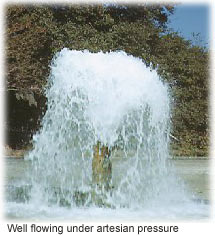 Bottled water is a very popular beverage nowadays all over the world. Sometimes it is because the local drinking water is of lower quality and sometimes it is just a convenience. Some bottled water is advertised as "artesian well water". Is the water really any different than other ground water?
Bottled water is a very popular beverage nowadays all over the world. Sometimes it is because the local drinking water is of lower quality and sometimes it is just a convenience. Some bottled water is advertised as "artesian well water". Is the water really any different than other ground water?
Artesian well water is not really different from non-artesian well water - but it comes to the surface in a different manner. In the diagram above, you can see that there are unconfined and confined aquifers in the ground. The confinement of water in an aquifer, which can result in pressure, determines if water coming from it is artesian or not. Wells drilled into confined aquifers can yield artesian water.
So, in what way is bottled artesian well water different from other well water? Mainly, the company that bottles it doesn't have to go to the expense of installing a pump in their well, so wouldn't you think that artesian water should be cheaper than non-artesian water?
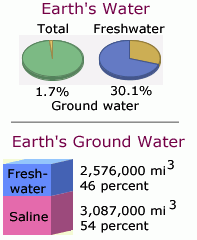 As these charts show, even though the amount of water locked up in ground water is a small percentage of all of Earth's water, it represents a large percentage of total freshwater on Earth. The pie chart shows that about 1.7 percent of all of Earth's water is ground water and about 30.1 percent of freshwater on Earth occurs as ground water. As the bar chart shows, about 5,614,000 cubic miles (mi3), or 23,400,000 cubic kilometers (km3), of ground water exist on Earth. About 54 percent is saline, with the remaining 2,526,000 mi3 (10,530,000 km3) , about 46 percent, being freshwater.
As these charts show, even though the amount of water locked up in ground water is a small percentage of all of Earth's water, it represents a large percentage of total freshwater on Earth. The pie chart shows that about 1.7 percent of all of Earth's water is ground water and about 30.1 percent of freshwater on Earth occurs as ground water. As the bar chart shows, about 5,614,000 cubic miles (mi3), or 23,400,000 cubic kilometers (km3), of ground water exist on Earth. About 54 percent is saline, with the remaining 2,526,000 mi3 (10,530,000 km3) , about 46 percent, being freshwater.
| Water source | Water volume, in cubic miles | Water volume, in cubic kilometers | Percent of total water | Percent of total freshwater | |
|---|---|---|---|---|---|
| Fresh ground water | 2,526,000 | 10,530,000 | 0.8% | 30.1% | |
| Ground water | 5,614,000 | 23,400,000 | 1.7% | -- | |
| Total global water | 332,500,000 | 1,386,000,000 | -- | -- | |
| Source: Gleick, P. H., 1996: Water resources. In Encyclopedia of Climate and Weather, ed. by S. H. Schneider, Oxford University Press, New York, vol. 2, pp.817-823. | |||||
![]() Ground Water
and Surface Water A Single Resource, USGS Circular 1139
Ground Water
and Surface Water A Single Resource, USGS Circular 1139
![]() NASA Earth Observatory; The Water Cycle
NASA Earth Observatory; The Water Cycle
![]() USGS: Ground-water data for the Nation
USGS: Ground-water data for the Nation
![]() USGS Ground Water Atlas of the United States
USGS Ground Water Atlas of the United States
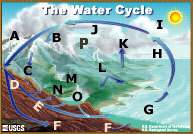 |
A - Storage in ice and snow B - Precipitation C - Snowmelt runoff to streams D - Infiltration E - Ground-water discharge F - Ground-water storage G - Water storage in oceans H - Evaporation |
I - Condensation J - Water storage in the atmosphere K - Evapotranspiration L - Surface runoff M - Streamflow N - Springs O - Freshwater storage P - Sublimation |